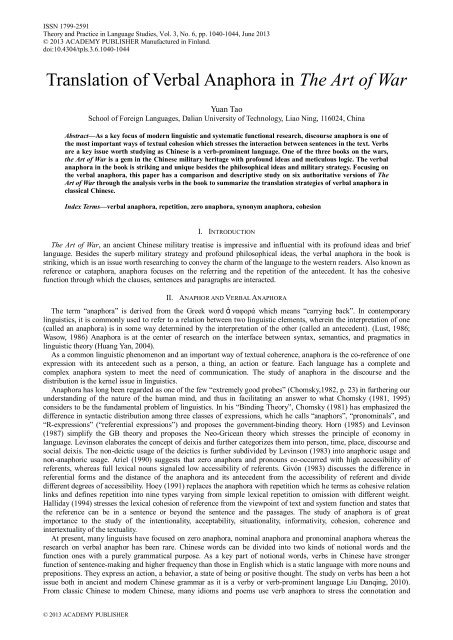Theory and Practice in Language Studies Contents - Academy ...
Theory and Practice in Language Studies Contents - Academy ...
Theory and Practice in Language Studies Contents - Academy ...
You also want an ePaper? Increase the reach of your titles
YUMPU automatically turns print PDFs into web optimized ePapers that Google loves.
ISSN 1799-2591<strong>Theory</strong> <strong>and</strong> <strong>Practice</strong> <strong>in</strong> <strong>Language</strong> <strong>Studies</strong>, Vol. 3, No. 6, pp. 1040-1044, June 2013© 2013 ACADEMY PUBLISHER Manufactured <strong>in</strong> F<strong>in</strong>l<strong>and</strong>.doi:10.4304/tpls.3.6.1040-1044Translation of Verbal Anaphora <strong>in</strong> The Art of WarYuan TaoSchool of Foreign <strong>Language</strong>s, Dalian University of Technology, Liao N<strong>in</strong>g, 116024, Ch<strong>in</strong>aAbstract—As a key focus of modern l<strong>in</strong>guistic <strong>and</strong> systematic functional research, discourse anaphora is one ofthe most important ways of textual cohesion which stresses the <strong>in</strong>teraction between sentences <strong>in</strong> the text. Verbsare a key issue worth study<strong>in</strong>g as Ch<strong>in</strong>ese is a verb-prom<strong>in</strong>ent language. One of the three books on the wars,the Art of War is a gem <strong>in</strong> the Ch<strong>in</strong>ese military heritage with profound ideas <strong>and</strong> meticulous logic. The verbalanaphora <strong>in</strong> the book is strik<strong>in</strong>g <strong>and</strong> unique besides the philosophical ideas <strong>and</strong> military strategy. Focus<strong>in</strong>g onthe verbal anaphora, this paper has a comparison <strong>and</strong> descriptive study on six authoritative versions of TheArt of War through the analysis verbs <strong>in</strong> the book to summarize the translation strategies of verbal anaphora <strong>in</strong>classical Ch<strong>in</strong>ese.Index Terms—verbal anaphora, repetition, zero anaphora, synonym anaphora, cohesionI. INTRODUCTIONThe Art of War, an ancient Ch<strong>in</strong>ese military treatise is impressive <strong>and</strong> <strong>in</strong>fluential with its profound ideas <strong>and</strong> brieflanguage. Besides the superb military strategy <strong>and</strong> profound philosophical ideas, the verbal anaphora <strong>in</strong> the book isstrik<strong>in</strong>g, which is an issue worth research<strong>in</strong>g to convey the charm of the language to the western readers. Also known asreference or cataphora, anaphora focuses on the referr<strong>in</strong>g <strong>and</strong> the repetition of the antecedent. It has the cohesivefunction through which the clauses, sentences <strong>and</strong> paragraphs are <strong>in</strong>teracted.II. ANAPHOR AND VERBAL ANAPHORAThe term “anaphora” is derived from the Greek word ἀ ναφορά which means “carry<strong>in</strong>g back”. In contemporaryl<strong>in</strong>guistics, it is commonly used to refer to a relation between two l<strong>in</strong>guistic elements, where<strong>in</strong> the <strong>in</strong>terpretation of one(called an anaphora) is <strong>in</strong> some way determ<strong>in</strong>ed by the <strong>in</strong>terpretation of the other (called an antecedent). (Lust, 1986;Wasow, 1986) Anaphora is at the center of research on the <strong>in</strong>terface between syntax, semantics, <strong>and</strong> pragmatics <strong>in</strong>l<strong>in</strong>guistic theory (Huang Yan, 2004).As a common l<strong>in</strong>guistic phenomenon <strong>and</strong> an important way of textual coherence, anaphora is the co-reference of oneexpression with its antecedent such as a person, a th<strong>in</strong>g, an action or feature. Each language has a complete <strong>and</strong>complex anaphora system to meet the need of communication. The study of anaphora <strong>in</strong> the discourse <strong>and</strong> thedistribution is the kernel issue <strong>in</strong> l<strong>in</strong>guistics.Anaphora has long been regarded as one of the few “extremely good probes” (Chomsky,1982, p. 23) <strong>in</strong> further<strong>in</strong>g ourunderst<strong>and</strong><strong>in</strong>g of the nature of the human m<strong>in</strong>d, <strong>and</strong> thus <strong>in</strong> facilitat<strong>in</strong>g an answer to what Chomsky (1981, 1995)considers to be the fundamental problem of l<strong>in</strong>guistics. In his “B<strong>in</strong>d<strong>in</strong>g <strong>Theory</strong>”, Chomsky (1981) has emphasized thedifference <strong>in</strong> syntactic distribution among three classes of expressions, which he calls “anaphors”, “pronom<strong>in</strong>als”, <strong>and</strong>“R-expressions” (“referential expressions”) <strong>and</strong> proposes the government-b<strong>in</strong>d<strong>in</strong>g theory. Horn (1985) <strong>and</strong> Lev<strong>in</strong>son(1987) simplify the GB theory <strong>and</strong> proposes the Neo-Gricean theory which stresses the pr<strong>in</strong>ciple of economy <strong>in</strong>language. Lev<strong>in</strong>son elaborates the concept of deixis <strong>and</strong> further categorizes them <strong>in</strong>to person, time, place, discourse <strong>and</strong>social deixis. The non-deictic usage of the deictics is further subdivided by Lev<strong>in</strong>son (1983) <strong>in</strong>to anaphoric usage <strong>and</strong>non-anaphoric usage. Ariel (1990) suggests that zero anaphora <strong>and</strong> pronouns co-occurred with high accessibility ofreferents, whereas full lexical nouns signaled low accessibility of referents. Givón (1983) discusses the difference <strong>in</strong>referential forms <strong>and</strong> the distance of the anaphora <strong>and</strong> its antecedent from the accessibility of referent <strong>and</strong> dividedifferent degrees of accessibility. Hoey (1991) replaces the anaphora with repetition which he terms as cohesive relationl<strong>in</strong>ks <strong>and</strong> def<strong>in</strong>es repetition <strong>in</strong>to n<strong>in</strong>e types vary<strong>in</strong>g from simple lexical repetition to omission with different weight.Halliday (1994) stresses the lexical cohesion of reference from the viewpo<strong>in</strong>t of text <strong>and</strong> system function <strong>and</strong> states thatthe reference can be <strong>in</strong> a sentence or beyond the sentence <strong>and</strong> the passages. The study of anaphora is of greatimportance to the study of the <strong>in</strong>tentionality, acceptability, situationality, <strong>in</strong>formativity, cohesion, coherence <strong>and</strong><strong>in</strong>tertextuality of the textuality.At present, many l<strong>in</strong>guists have focused on zero anaphora, nom<strong>in</strong>al anaphora <strong>and</strong> pronom<strong>in</strong>al anaphora whereas theresearch on verbal anaphor has been rare. Ch<strong>in</strong>ese words can be divided <strong>in</strong>to two k<strong>in</strong>ds of notional words <strong>and</strong> thefunction ones with a purely grammatical purpose. As a key part of notional words, verbs <strong>in</strong> Ch<strong>in</strong>ese have strongerfunction of sentence-mak<strong>in</strong>g <strong>and</strong> higher frequency than those <strong>in</strong> English which is a static language with more nouns <strong>and</strong>prepositions. They express an action, a behavior, a state of be<strong>in</strong>g or positive thought. The study on verbs has been a hotissue both <strong>in</strong> ancient <strong>and</strong> modern Ch<strong>in</strong>ese grammar as it is a verby or verb-prom<strong>in</strong>ent language Liu Danq<strong>in</strong>g, 2010).From classic Ch<strong>in</strong>ese to modern Ch<strong>in</strong>ese, many idioms <strong>and</strong> poems use verb anaphora to stress the connotation <strong>and</strong>© 2013 ACADEMY PUBLISHER
















